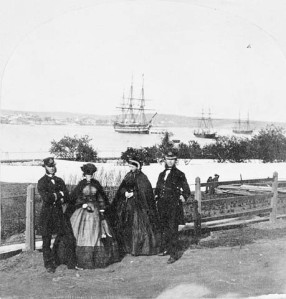
Canada — For Immediate Release : “TO CANADA” bringing in sacks of money “FOR INVESTMENT IN CANADA”
Postcard (postmarked 1907) depicting John Bull and Uncle Sam under sign “To Canada” bringing in sacks of money “for investment in Canada”
To Canada for investment in Canada is a postcard dated back in 1907. Canada’s history of investment began even before 1917 and is steeped in global partnerships. The UK and US invested in Canada to help fuel economic growth as pictured in this postcard in 1907.
“To Canada,” John Bull and Uncle Sam bringing in sacks of money “for investment in Canada.”
The Style of BULL – “blue & buff”
Who is John Bull? – Originally created in 1712 by Dr. John Arbuthnot – to represent the heoricarchetype of the freeborn Englishman. So, John Bull – was an example of the well-intentioned, jolly, frustrated, full of common sense and entirely of native country stock type of character. He represented the helpers, the assistants, and the yeoman who preferred his small beer and domestic peace.
What is blue & buff? Arbuthnot always made sure John wore his red topcoat, and royal blue tailcoat with white pants and top hat. (the Union Jack colours). During the Georgian period John Bull’s waistcoat was red and his tailcoat royal blue with white breeches, and sources state this is how the ‘blue and buff’ scheme may have started...
 1700s – blue & buff –——–The Duchess of Devonshire, Georgiana Cavendish, first woman to use color to make a political statement. During these times, women were seen more as property. They were not allowed to own anything, have a profession and not allowed to vote.
1700s – blue & buff –——–The Duchess of Devonshire, Georgiana Cavendish, first woman to use color to make a political statement. During these times, women were seen more as property. They were not allowed to own anything, have a profession and not allowed to vote.
The Duchess of Devonshire cleverly used color to rally support for her favorite political party – the Whigs, whose colors were blue and buff. During the 1700s, Gerogiana had to get creative if she wanted to make a political statement. That she did – wearing royal blue extravagant dresses and inspiring other wealthy women to show up at political rallies in blue and buff gowns.
Even, famous singer David Bowie took part many years later….wearing a coat in the style of ‘Bull’.
Historical Investing in Canada & economic development– Thumbs Up!
Colonial times – economic development based on mercantilism & philosophy maximum returns from material benefits in Canada (then New France) with minimum imperial investment.
Royal Charter – first corporations to operate in Canada were: La Compagnie des Marchands, (1613 to 1621), Compagnie de Montmorency, (1621 to 1627), replaced by La Compagnie des Cent-Associes (1627 to 1643).
1713 – Britain acquired Acadia and promoted Maritime agriculture. Financial incentives were offered to settlers to settle, clear and fence their land in Halifax, Nova Scotia. In PEI, the govt. granted 66 lots to private individuals.
1792 – Canada’s first bank founded in Montreal – the Canada Banking Company
1800s – French or British govt. initially seemed unprepared to spend much money or energy to encourage settlement as they wished to keep the lucrative trade with native people. This eventually changed and Europeans invested and encouraged settlement in Canada. Early 1800’s, economies of Canadian Maritimes most industrialized, and prosperous in British North America. During the economic activity of the colonial business elite, capitalism evolved, and with it the Canadian banking financial system.
1817 – Bank of Montreal
1820 – Bank of New Brunswick
1821 – Bank of Upper Canada
1832 – establishment of the Montreal Stock Exchange
1846 – repeal of the Corn Laws, Parliament of Britain, terminated colonial trading preferences marking end of mercantilism & new era of capitalism
 1850s & 1860s – Canadian Maritimes especially prosperous. Thumbs up!
1850s & 1860s – Canadian Maritimes especially prosperous. Thumbs up!
1861 – Toronto Stock Exchange
1865 – Sun Life Insurance
1867 – Confederation
1870 – Mutual Life Insurance
1871 – Confederation Life Insurance
1871 – newly formed Government of Canada Bank Act
1871 -Dominion Lands Act – efforts to settle west of Canada
1874 – London Life Insurance
1886 – 38 banks chartered
1904 – Winnipeg Commodity Exchange
Fast forward to 1990 – 2012
1990s – the number of entrepreneurs in Canada rose dramatically. Number of entrepreneurial-class immigrants came seeking opportunities for capital investment in Canada.
2011 – Foreign direct investors invest funds in Canada second quarter with additional inflow of $14.5 billion, after two quarters of investment totalling $23.5 billion. Cross-border merger & acquisitions strengthen further in quarter, accounting for the bulk of the investment. United States investors led investment concentrating on Canadian energy and metallic mineral sectors. Investment mostly directed to finance and insurance sectors.
Canada number One – ranking & standing among 139 countries. Thumbs up!
Ranking based on the degree of soundness of financial institutions. Source: Global Competitiveness Report, 2010-11 ** Standing among 500 world banks based on total assets and long-term credit ratings. Source: Global Finance Magazine , September 2010
The Famous Five or The Valiant Five were five Canadian women who challenged the Supreme Court of Canada – “Does the word ‘Persons’ in Section 24 of the British North America Act, 1867, include female persons?
The petition was filed 1927 and summarized that women are not persons. This case came to become known as The Persons Case. The case was overturned and made progress for women’s rights and engendered a radical change in the Candian judicial approach to the Canadian constitution, an approach known as the “living tree doctrine.”
The five women known as “trailblazers” were:
Emily Murphy (the British Empire’s first female judge
Irene Marryat Parlby (farm women’s leader, activist & first female Cabinet minister in Alberta)
Nellie Mooney McClung (a suffragist & member of the Alberta legislature)
Louise Crummy McKinney (first woman elected to the Legislative Assembly of Alberta, or any legislature in Canada or the rest of the British Empire)
Henrietta Muir Edwards (an advocate for working women and a founding member of the Victoria Order of Nurses).
Foreign investment in Canada, 2009
Related articles
- Today, Impact Investing Goes Mainstream in Canada (socialfinance.ca)
- Today, impact investing goes mainstream in Canada (marsdd.com)



